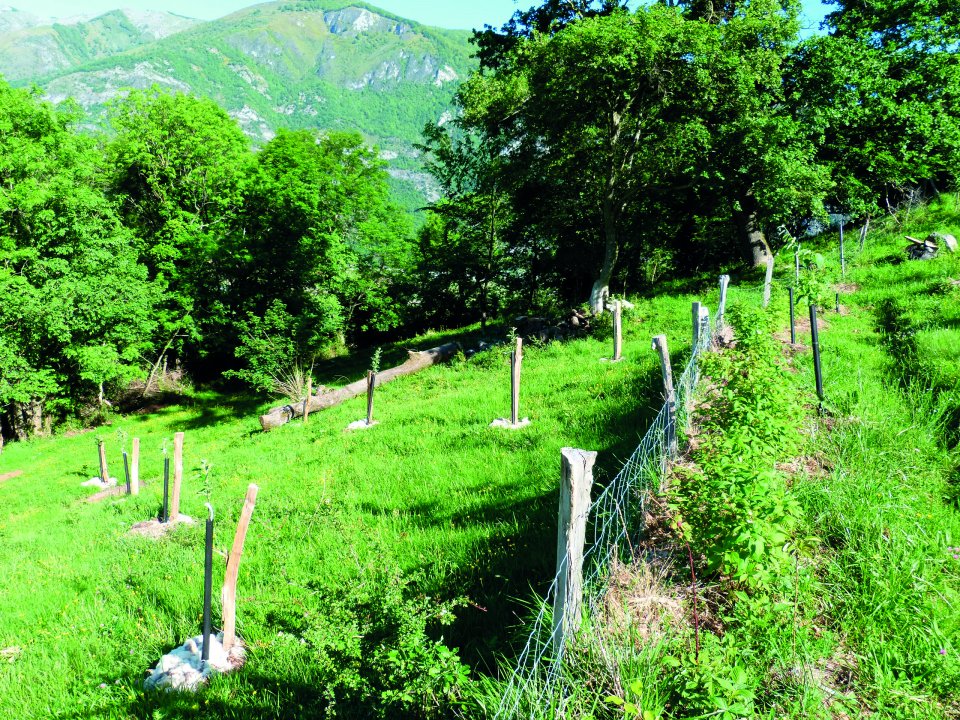
Agricultural ecosystems
PROJECT OBJECTIVES
• For climate change adaptation : improve farming resilience by favouring tree species that are adapted and resistant to local soil and climatic conditions, and which contribute to the infiltration of run-off water into the soil.
• For biodiversity: use trees as a base for biodiversity and preserve ancient varieties of fruit trees.
• For the local community: create a botanical conservatory made of ancient endemic varieties, and increase the supply of fresh produce in the area
On two plots of land certified as organic, planted in part with fruit trees and grazed by about twenty Lourdais sheep (a hardy local breed), the project aims to fulfil the farm’s tree capital..
• Hedge planting: 500 hedge plants of fruit bushes and diversified rural trees (serviceberry, viburnum, willow, elder, common dogwood, mahonia, purple hazel, cherry plum, black alder, hedge maple, medlar, strawberry, raspberry).
• Parcel the plots with grafted trees: 510 fruit trees, mainly apple, pear and plum trees, as well as well as apricot, peach, cherry and fig trees.
• Preparation and plantation protection works: creation of terraces; installation of fences to prevent access by game and sheep.
• Creation of a rainwater retention basin to compensate for the lack of water during summer.
BENEFITS REGARDING ADAPTATION CHALLENGES :
- Improvement in the farm’s resilience (against droughts, floods, frost etc).
- Reduction in soil erosion and leaching over sloped lands.
- Improvement in shading and windbreak effects throughout the farm
BENEFITS FOR BIODIVERSITY :
- Improvement in the symbiosis between the crops and the local fauna, which favours greater species diversity (birds, wild bees).
- Preservation of the cultivated biodiversity of the area by choosing ancient varieties of fruit trees that are both endemic and resistant to climatic hazards.
OTHER BENEFITS :
- Socio-economic benefits:
increase the local supply of fresh and healthy produce in the area.
- Climate change mitigation: CO 2 sequestration through planted trees.
- Developing climate change adaptation; improving risk management and resilience
- Reduce drought risk
- Reduce risk of damages from drought
- Reduce run-off
- Restoring ecosystems and their functions
- Increase Biodiversity
- Increase willingness to invest in NBS
LEVERS FOR SUCCESS TECHNICAL ASPECTS AND PROJECT DESIGN
• Experiment fast-growing varieties: plant the trees close to one another (every 1.20 m) and choose varieties known for providing fruits quickly (within 3 years). It will allow you to assess their suitability to the natural characteristics of the soil and climate.
• Choice of rootstock: choose one adapted to the pedoclimatic context (e.g., MM111 adapted to dry and well drained soils) and favour rootstock with a small root system to avoid competition with market gardening crops.
• Think your plantation plan according to the slopes exposure and make sure that the fruit trees’ roots run deep into the soil to avoid competing with marking gardening crops’ water stocks.
• Protect the crops: It is important to protect the plots up on a headland against the wind by planting evergreen trees in tiers to create microclimates.
• Adapt to the terrain: farmers created terraces to cultivate the plots regardless of the slope. A lot of leaching in the first few years until the soil became fertile and productive.
• Anticipate the risk of damage caused by ungulates (Red Deer, Roe Deer): setting up a fence at least 1.80 m high to prevent ungulates from jumping over.
STAKEHOLDER COMMITMENT
• Join the the local producers’ and farmers’ networks: share the best practices and encourage the creation of a local market. ACTION MONITORING AND REPLICABILITY
• Pass on experience: Yohan and Marion welcome trainees and train other tree growers in fruit tree grafting. GAVE 65 and the SMART network came for a technical visit to learn more about the project’s integrated approach.
• Consolidate economic viability: Consider diversifying activities and production to improve the farm’s resilience to hazards, for instance : make sure you have products to sell in all seasons and strengthen the autonomy of your production through the fruit tree grafting cycles, a longer yet more resilient process.
Yohan Caubet -Farmer
Further information
The feedback sheets of Nature-Based Solutions for climate adaptation projects developed by CDC-Biodiversité, the French UICN Committee, and the OFB as part of the Life ARTISAN project aim to inspire public and private decision-makers, planners, forest and agricultural landowners, or protected area managers interested in implementing a Nature-Based Solutions project. The sheets provide information on the socio-economic and ecological contexts and challenges, financing sources and budget, actors and stakeholders involved, governance, actions taken, expected or observed results, monitoring indicators, as well as success factors and recommendations.
The Sarrat Farm project (2019-2050) in the Hautes-Pyrénées is dedicated to enhancing farm resilience through nature-based solutions that address droughts, floods, and frost. The farm has successfully reduced soil erosion and improved water retention on sloped lands while also enhancing shading and windbreak capabilities. Biodiversity has been significantly bolstered by fostering symbiotic relationships between crops and local fauna, and by preserving ancient, climatically resilient fruit tree varieties. Additionally, the project contributes socio-economic benefits by increasing the local availability of fresh, healthy produce and aids in climate change mitigation through effective CO2 sequestration by the newly planted trees.
